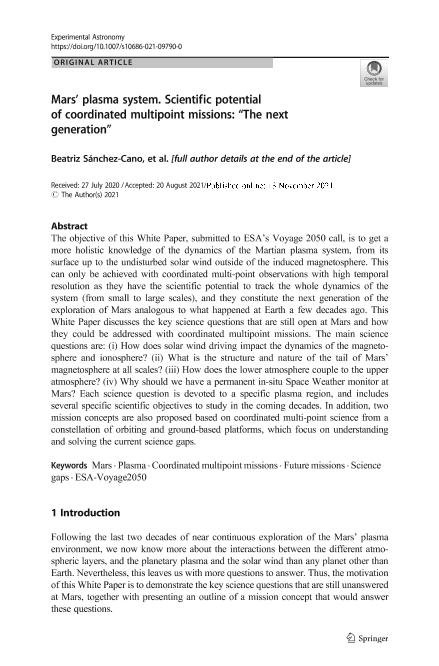Artículo
Mars’ plasma system: Scientific potential of coordinated multipoint missions: “The next generation”
Sánchez Cano, Beatriz; Lester, Mark; Andrews, David J.; Opgenoorth, Hermann; Lillis, Robert; Leblanc, François; Fowler, Christopher M.; Fang, Xiaohua; Vaisberg, Oleg; Mayyasi, Majd; Holmberg, Mika; Guo, Jingnan; Hamrin, Maria; Mazelle, Christian; Peter, Kerstin; Pätzold, Martin; Stergiopoulou, Katerina; Goetz, Charlotte; Ermakov, Vladimir Nikolaevich; Shuvalov, Sergei; Wild, James A.; Blelly, Pierre Louis; Mendillo, Michael; Bertucci, Cesar ; Cartacci, Marco; Orosei, Roberto; Chu, Feng; Kopf, Andrew J.; Girazian, Zachary; Roman, Michael T.
; Cartacci, Marco; Orosei, Roberto; Chu, Feng; Kopf, Andrew J.; Girazian, Zachary; Roman, Michael T.
 ; Cartacci, Marco; Orosei, Roberto; Chu, Feng; Kopf, Andrew J.; Girazian, Zachary; Roman, Michael T.
; Cartacci, Marco; Orosei, Roberto; Chu, Feng; Kopf, Andrew J.; Girazian, Zachary; Roman, Michael T.
Fecha de publicación:
11/2021
Editorial:
Springer
Revista:
Experimental Astronomy
ISSN:
0922-6435
Idioma:
Inglés
Tipo de recurso:
Artículo publicado
Clasificación temática:
Resumen
The objective of this White Paper, submitted to ESA’s Voyage 2050 call, is to get a more holistic knowledge of the dynamics of the Martian plasma system, from its surface up to the undisturbed solar wind outside of the induced magnetosphere. This can only be achieved with coordinated multi-point observations with high temporal resolution as they have the scientific potential to track the whole dynamics of the system (from small to large scales), and they constitute the next generation of the exploration of Mars analogous to what happened at Earth a few decades ago. This White Paper discusses the key science questions that are still open at Mars and how they could be addressed with coordinated multipoint missions. The main science questions are: (i) How does solar wind driving impact the dynamics of the magnetosphere and ionosphere? (ii) What is the structure and nature of the tail of Mars’ magnetosphere at all scales? (iii) How does the lower atmosphere couple to the upper atmosphere? (iv) Why should we have a permanent in-situ Space Weather monitor at Mars? Each science question is devoted to a specific plasma region, and includes several specific scientific objectives to study in the coming decades. In addition, two mission concepts are also proposed based on coordinated multi-point science from a constellation of orbiting and ground-based platforms, which focus on understanding and solving the current science gaps.
Archivos asociados
Licencia
Identificadores
Colecciones
Articulos(IAFE)
Articulos de INST.DE ASTRONOMIA Y FISICA DEL ESPACIO(I)
Articulos de INST.DE ASTRONOMIA Y FISICA DEL ESPACIO(I)
Citación
Sánchez Cano, Beatriz; Lester, Mark; Andrews, David J.; Opgenoorth, Hermann; Lillis, Robert; et al.; Mars’ plasma system: Scientific potential of coordinated multipoint missions: “The next generation”; Springer; Experimental Astronomy; 54; 2-3; 11-2021; 641-676
Compartir
Altmétricas



